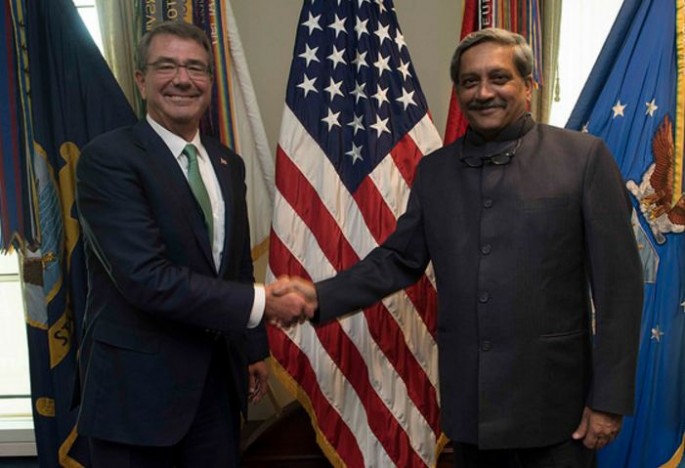India has opened its defense industry to United States' investors and defense firms in the latest move indicating India has moved much closer to the U.S.' orbit and further away from Moscow's.
Indian Defense Minister Manohar Parrikar, who is in the U.S. for a three-day visit starting Aug. 29, said in a meeting with U.S. Secretary of Defense Ash Carter he intends to return to India having increased ties between the U.S. defense industry and that of India.
Parrikar said a major goal of his trip to the U.S. is to encourage future tie-ups between US and Indian defense firms. He will also meet with top defense technology experts from the military, the business sector and the academe.
"I wish to invite US industry, including the defense industry, to be part of this new journey of hope and transformation in India," said Parrikar.
On Aug. 30, Parrikar will meet with representatives from 25 U.S. business firms including Boeing, Lockheed Martin and Textron in a meeting organized by the US-India Business Council.
Carter described Parrikar as "an innovator. He's a great partner and a true friend." He repeated his belief the U.S.-India relationship is "destined to be one of the defining partnerships of the 21st century."
Both leaders noted the importance of India being named a Major Defense Partner in June, an event Carter described as an "enormous change." India received this designation during the official visit to the U.S. by Indian Prime Minister Narendra Modi.
"Across the board of what we do, whether they are co-production, co-development, whether they are exercises and the kinds of things that we do operationally together, in all of those respects, some of the barriers that were erected in the past when we didn't interact so much, all those are being knocked down," said Carter.
Following a meeting between President Barack Obama and Prime Minister Modi last June, the White House released a joint statement acknowledging the US-India defense relationship as a "possible anchor of stability," and heralding new technology sharing "at a level commensurate with that of its closest allies and partners."
The leaders reached an understanding under which India would receive license-free access to a wide range of dual-use technologies along with unspecified steps that India has committed to take to advance its export control objectives.
"I think the Modi government is taking some very positive steps to promote more co-development and co-production in the defense sector," said Ben Schwartz, Director for Defense and Aerospace, of the US-India Business Council.
"There really is forward momentum at the political level. What remains to be done is working things out more at the level that occurs at the companies, and the lower level people at the Indian government in the acquisition system."
Schwartz claims the most significant policy shift of the government of Indian Prime Minister Modi has been opening up the defense sector to private industry.
"That was pretty substantial," said Schwartz.
In addition to industry, Parrikar met with the leadership of the Defense Advanced Research Projects Agency (DARPA) and the Defense Innovation Unit Experimental (DIUx) group.
Parrikar will also visit U.S. Cyber Command, Air Combat Command and the 480th Intelligence, Surveillance and Reconnaissance Wing.
The highlight of Parikar's trip will be signing the Logistics Exchange Memorandum of Agreement (LEMOA), a foundational agreement for India and the U.S. that will allow the military forces of both nations to use each other's military bases.
LEMOA means India will allow U.S. forces to operate out of its military bases and vice versa. The agreement will give each nation access supplies, spare parts and services from each other's land facilities, air bases and ports, which can then be reimbursed, according to India's Ministry of Defense.
The ministry also said LEMOA does not give automatic access to the use of each nation's military bases.
LEMOA is seen as part of President Barack Obama's pivot to Asia and caps 12 years of unrelenting effort by the U.S. Under the pivot meant to rein in communist China and its imperialistic leaders, the U.S. Navy plans to deploy 60 percent of its surface ships to the Indo-Pacific with this decade.



























